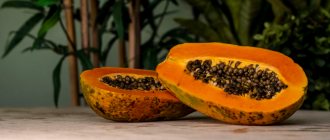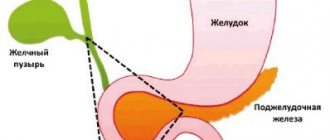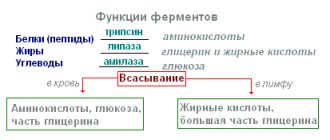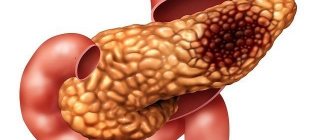Composition of pancreatic juice. Properties of pancreatic juice. Pancreatic enzymes.
Pancreatic juice
has a high concentration of bicarbonates, which determine its alkaline reaction. Its pH ranges from 7.5 to 8.8. The juice contains sodium, potassium and calcium chlorides, sulfates and phosphates. Water and electrolytes are secreted mainly by the centroacinar and epithelial cells at the outlets of the ducts. The juice also contains mucus, which is produced by the goblet cells of the main pancreatic duct.
Pancreatic juice
rich in enzymes that hydrolyze proteins, fats and carbohydrates.
They are produced by acinar pancreatocytes
.
Proteolytic enzymes
(trypsin, chymotrypsin, elastase, carboxypeptidases A and B) are secreted by pancreatic cells in an inactive state, which prevents self-digestion of cells.
Trypsinogen
is converted into trypsin in the duodenum under the influence of the enzyme enterokinase, which is produced by the intestinal mucosa. The release of entorokinisis is due to the influence of bile acids. With the appearance of trypsin, an autocatalytic process of activation of all proteolytic enzymes secreted in the zymogenic form begins.
Trypsin
,
chymotrypsin
and
elastase
break down the internal peptide bonds of the protein molecule and high molecular weight polypeptides.
The hydrolysis process ends with the formation of low molecular weight peptides and amino acids. The resulting peptides
undergo final hydrolysis by carboxypeptidases A and B, which cleave the C-terminal bonds of protein and peptide molecules to form amino acids.
amylase contained in pancreatic juice
breaks down starch into dextrins, maltose and maltotriose. Calcium ions included in the composition of os-amylase ensure the stability of the enzyme when the pH of the environment and its temperature changes, and also prevent its hydrolysis under the influence of proteolytic enzymes.
Pancreatic lipase
secreted in active form.
But its activity increases significantly under the influence of colipase after its activation in the duodenum by trypsin. Colipase
forms a complex with pancreatic lipase. Salts of fatty acids participate in the formation of this complex. Lipase hydrolyzes fat into monoglycerides and fatty acids. The efficiency of fat hydrolysis increases sharply after its emulsification with bile acids and their salts.
Under the influence of cholesterolase
cholesterol is broken down into cholesterol and fatty acids. Phospholipids undergo hydrolysis by pancreatic phospholipase A2, which is activated by trypsin. The end products of hydrolysis are fatty acid and isolecetin. Ribonucleases and deoxyribonucleases of pancreatic juice break down RNA and DNA of nutrients into nucleotides.
Physicochemical properties and functions
Due to the fact that pancreatic juice contains a large amount of proteolytic enzymes and minerals, it has an alkaline reaction (pH ranges from 7.5 to 8.9). Regulation of the secretion of pancreatic juice is carried out through the endocrine system and nerve impulses. Up to 2 liters of juice are released per day.
Its main functions:
- Intracavitary digestion (in the cavity of the small intestine): the initial digestion of nutrients with their breakdown into their constituent elements.
- Parietal digestion: digestion of undigested food residues immediately before their absorption into the blood near the villi of the small intestine.
- Activation of digestive enzymes.
- Enveloping and softening the food bolus.
Importance for the body
Pancreatic juice is a solution of the gastrointestinal tract, formed by the pancreas and flowing into the duodenum through the Wirsung duct, as well as the accessory duct and the large and small duodenal papilla.
Pancreatic secretion in its pure form is obtained from animals using unnatural fistulas, when a tube is inserted into the organ's excretory canal, through which juice temporarily flows out, which represents temporary fistulas.
In appearance, pancreatic juice is a clear, colorless solution that has the highest alkaline content and is provided by bicarbonates.
The withdrawal and regulation of pancreatic secretion is carried out using the nervous and wet pathways, with the secretion fibers of the traveling and receptive nerves, and the hormone septin. The separation of juice by a normal stimulus is carried out:
- food;
- bile;
- hydrochloric and other acid.
proper nutrition
The amount of pancreatic juice produced by the pancreas is about 2 liters per day. In this case, the volume of secretion may vary somewhat, it all depends on the influence of a number of factors.
- Physical exercise.
- Age.
- Composition of consumed dishes.
In case of excessive secretion production, pancreatitis is formed. The pathology is represented by acute or chronic damage to the organ secreted by this secretion - the pancreas. A deficiency in the volume of pancreatic juice can provoke an unbearable desire to eat.
But at the same time, regardless of frequent meals, a person still does not gain weight, since the food eaten is not absorbed in sufficient quantities by the body.
Based on the volume of pancreatic juice secreted by the pancreas, the following is formed:
- dissolution and dilution of food to a greater or lesser extent, which is determined by the stage of adsorption of juice enzymes;
- a favorable atmosphere for enzymes is formed, which provides the environment for absorption.
P. juice is released under a pressure of 225 mm of water column. On an empty stomach and during a fast, secretion does not appear; it occurs some time after eating and quickly reaches its maximum level, after which it decreases again and after 10 hours it increases from the initial consumption of foods.
secretion of pancreatic juice
How to influence the secretion of pancreatic juice
The secretion of pancreatic juice can be positively influenced if:
- Eat right - exclude fatty, spicy, fried foods from the menu.
- Lead a healthy lifestyle. Doctors recommend that people with constantly reduced secretion of pancreatic juice, as well as patients with pancreatitis, give up smoking and drinks containing even a minimal amount of alcohol.
- Drink herbal decoctions and infusions regularly. The production of enzymes is facilitated by a collection of medicinal chamomile, lemon balm, peppermint and immortelle flowers.
In addition, it is very important to drink at least 1.5 liters of plain water daily. The pancreas needs a large amount of fluid so that it can produce enough bicarbonate of alkali solution to neutralize gastric acid in the duodenum.
1
Importance for the body
The pancreas consists of parenchyma (its own tissue) divided into lobules, or acini. The cells of these small structures produce pancreatic (pancreas - pancreas) secretion, which flows through the ducts into the common excretory canal, which opens into the lumen of the duodenum. Almost the entire volume of pancreatic juice, which reaches about 2 liters per day, gradually ends up in the small intestine, which helps food to be digested efficiently. Therefore, the secretion of the pancreas is often called digestive juice.
Various components of the secretion are produced by special cells of the organ
In most people, the main duct of the gland, before flowing into the duodenum, is united with the gallbladder canal, that is, the secretion of the pancreas in the small intestine is already mixed with bile. Considering that the maximum secretory activity of the pancreas and gall bladder is associated with food intake, this anatomical feature turns out to be very useful, since it ensures complete and simultaneous processing of complex biochemical compounds, for example, fats through both pancreatic juice and bile.
However, this feature often leads to serious diseases, in particular to secondary pancreatitis, which becomes a consequence of pathologies of the bile ducts. This form of inflammation in the pancreas is caused by the reflux of bile not into the small intestine, but into the ducts of the gland, which most often becomes a consequence of biliary dyskinesias of the hypertensive type. As a result, the “foreign” secretion, namely bile, acts very aggressively on the parenchyma and leads to the development of a pronounced inflammatory process.
The production of secretions by the pancreas is regulated by special structures of the parasympathetic nervous system (vagus nerve), as well as by the humoral factor, that is, the activity of other organs of the digestive tract. The entry of food into the body primarily involves the stomach, where the reflex production of gastric juice containing hydrochloric acid begins while a person is chewing the first portion of food.
The complex chemical composition of gastric juice also provides for the presence of various enzymes. Of these, the most important compound that most directly affects the pancreas is gastrin. Its main role in relation to the gland is to ensure sufficient trophism of the organ (nutrient supply), which is the basis for the functionality of the pancreas.
The reflux of bile into the ducts of the gland provokes acute pancreatitis
In turn, hydrochloric acid affects the mucous membrane of the duodenum, where intensive production of enzymes begins, directly leading to the activation of the pancreas. These are secretin and cholecystokinin, which directly and almost instantly affect the acinar cells of the pancreas. That is why the beginning of food intake coincides with the functional “surge” of this endocrine organ.
What does the pancreas secrete?
The pancreas is one of the main organs of the endocrine and digestive systems. The dual function of this organ makes it irreplaceable, and the structure of the tissues means that any impact on the gland leads to their damage. The exocrine (exocrine) function of the pancreas is that special cells secrete digestive juice at every meal, due to which it is digested. The endocrine activity of the gland is the production of hormones involved in the main metabolic processes in the body. One of them is carbohydrate metabolism, which occurs with the participation of several pancreatic hormones.
Where is pancreatic juice formed and where does it go?
The parenchyma of the pancreas consists of glandular tissue. Its main components are lobules (acini) and islets of Langerhans. They provide external and intrasecretory function of the organ. The islets of Langerhans are located between the acini, their number is significantly smaller, and a larger number of them are located in the tail of the pancreas. They make up 1-3% of the total volume of the pancreas. The cells of the islets synthesize hormones that immediately enter the blood.
The exocrine part has a complex alveolar-tubular structure and secretes about 30 enzymes. The bulk of the parenchyma consists of lobules that look like vesicles or tubes, separated from each other by delicate connective tissue septa. They include:
- capillaries entwining the acinus with a dense network;
- lymphatic vessels;
- nerve elements;
- efferent duct.
Each acini consists of 6-8 cells. The secretion they produce enters the cavity of the lobule, and from there into the primary pancreatic duct. Several acini are combined into lobes, which in turn form larger segments of several lobes.
The small ducts of the lobules merge into a larger excretory canal of the lobe and segment, which flows into the main - Wirsung - duct. It stretches across the entire gland from the tail to the head, gradually expanding from 2 mm to 5 mm. In the head part of the pancreas, an additional duct, the Santorini duct, flows into the Wirsung canal (not in every person); the resulting duct connects to the common bile duct (common duct of the gallbladder). Through this so-called ampulla and the papilla of Vater, the contents enter the lumen of the duodenum.
Around the main pancreatic and common bile ducts and their common ampulla there is a significant amount of smooth muscle fibers that form the sphincter of Oddi. It regulates the flow of the required amount of pancreatic juice and bile into the lumen of the duodenum.
In general, the segmental structure of the pancreas resembles a tree; the number of segments varies individually from 8 to 18. They can be large, wide (sparsely branched version of the main duct) or narrow, more branched and numerous (densely branched duct). In the pancreas there are 8 orders of structural units that form such a tree-like structure: starting with the small acinus and ending with the largest segment (of which there are from 8 to 18), the duct of which flows into the virsung.
Acini cells synthesize, in addition to enzymes, which are proteins in chemical composition, a certain amount of other proteins. Ductal and central acinar cells produce water, electrolytes, and mucus.
Pancreatic juice is a clear liquid with an alkaline environment, which is provided by bicarbonates. They neutralize and alkalize the bolus of food coming from the stomach - chyme. This is necessary because the stomach produces hydrochloric acid. Thanks to its secretion, gastric juice has an acidic reaction.
Compound
P. juice, in contrast to gastric juice, is a liquid with a sharply alkaline reaction, which contributes to its activity. The enzymes contained in the juice help digest food components. The juice contains amylase, lipase, pancreatic elastase, nuclease, carboxypeptidase, trypsinogen, chymotrypsinogen.
Pancreatic amylase is similar to salivary alpha-amylase (ptyalin); but it acts more energetically and is capable of converting not only boiled but also raw starch into sugar. A change in the activity of this enzyme in the blood may indicate damage to the pancreas.
Pancreatic lipase leads to the formation of soap, since the fatty acid, which is the product of this breakdown, interacts with alkalis in the intestinal canal and produces soap, which plays an important role in the emulsification of fat, i.e. in its physical fragmentation into small droplets, which is necessary for the absorption of fat, i.e. for its absorption. The presence of this fat is easily proven by the following experiment: if you moisten blue litmus paper with neutral olive oil and apply it to the cut surface of the pancreas, the paper becomes covered with red dots, indicating the development of an acidic reaction in these places on the paper due to the formation of fatty oleic acid. This enzyme is very unstable and quickly loses activity in the presence of acids, so the accumulation of fatty acids in the medium inhibits its activity.
The enzyme that converts proteins into peptones was called trypsin by Kuehne; it acts in alkaline solutions (1% sodium carbonate solution). The protein, under the influence of this enzyme, breaks down into peptides, gradually turning into peptone, which is almost no different in its properties from ordinary peptones formed by gastric juice. But in addition to peptone, protein during P. digestion breaks down into leucine and tyrosine (from 4 to 10%). This enzyme has specificity and destroys peptide bonds formed by the basic amino acids - lysine and arginine.
Trypsin is not produced directly by gland cells, but is formed from a proenzyme (zymogen) called trypsinogen, which is formed through limited proteolysis by the enzyme enteropeptidase. The granular belt of cells of the P. gland consists of enmogen, formed from the transparent belt of cells, especially during the rest of the gland. With prolonged operation of the gland, this granular belt decreases due to the conversion of zymogen into trypsin, which is removed from the cell.
Enzymes are secreted by pancreatic cells in an inactive state, in the form of proenzymes, which prevents the digestion of the pancreas itself. Their activation occurs in the intestinal lumen. In case of premature activation of enzymes, a serious disease develops.
In addition to enzymes, pancreatic juice contains bicarbonates, which determine its alkaline environment (7.5 - 8.8). The juice also contains sodium, potassium and calcium chlorides, sulfates and phosphates.
Folk remedies for the pancreas
There are several simple traditional medicine recipes that help improve the functioning of the pancreas and increase the secretion of pancreatic juice.
Dill infusion
Pour a teaspoon of dill into a glass. Pour boiling water and wait for an hour. Then strain through a tea strainer. You need to drink the infusion in small portions throughout the day. By evening you need to consume it entirely.
Oats
One of the oldest traditional medicine recipes, which is suitable for people complaining of problems with the gastrointestinal tract, is oatmeal. And without salt and oil - these seasonings can further harm the diseased pancreas.
However, it is impossible to eat oatmeal poured with boiling water for a long time: it is practically tasteless and becomes boring very quickly. Then you can gradually return familiar dishes to your diet, and instead of oatmeal, use an infusion of oats. It is prepared like this: take two liters of boiling water per kilogram of washed grain. Pour into a saucepan, add boiling water and leave for an hour. After this, strain the infusion and pour it into a glass jar. Drink it three times a day, half a glass.
Taking this remedy can be combined with a few simple exercises that will help speed up your metabolism. The simplest thing is breathing exercises. It's done like this:
While standing or sitting (never slouching!) Inhale as deeply as possible. Then exhale slowly. Hold your breath and tighten your stomach. Count to three and inhale. This concludes the exercise. You need to repeat it ten times per knock.
Combination remedy for the pancreas
This remedy is more difficult to prepare and requires several ingredients, but it is much more effective. To make this extremely healthy potion, you will need pitted lemons, parsley and garlic. Grind a kilogram of thoroughly washed lemons in a meat grinder. Add fresh garlic and parsley, which we also twist. Mix thoroughly until it becomes a homogeneous paste. Place in a glass container (preferably a glass jar with a tight-fitting lid) and place in the refrigerator. Take a teaspoon fifteen minutes before breakfast, lunch and dinner.
If it seems to you that the therapeutic effect of this remedy is not sufficiently manifested, it can be strengthened with the help of another one:
- You will need strawberry, blueberry and lingonberry leaves, as well as corn silk and bean pods. We take them in equal quantities (we use scales for this) and put them in a thermos. Let sit for several hours and close the lid tightly. Then we drink a third of a glass after each dose of the remedy described above.
This remedy is very effective, and you can treat with it for up to three months without a break.
Buckwheat with kefir
A universal remedy for many diseases, including pancreatitis.
You need to prepare this remedy in the evening. Thoroughly wash and sort the buckwheat. Pour a glass of cereal into a glass bowl and pour in half a liter of kefir. We leave it to brew in the refrigerator or (if the room is cool) just on the table. After twelve hours, divide the porridge into two equal parts, one of which is put back in the refrigerator. We eat the first portion for breakfast, the second for dinner. To make the treatment more effective, it is advisable to abstain from other foods for a couple of days and eat only this remedy. In the future, you can eat low-fat chicken broth and vegetable stew for lunch. It is necessary to adhere to such a diet for ten to twelve days, then take a short break and repeat the course. Patients note that already 5-7 days after the start of the procedures, pain and bloating disappear.
Taking care of your health starts small: be attentive to your feelings, consult a doctor at the first warning symptoms - and you will be healthy.
Composition of pancreatic juice
Pancreatic juice contains 90% water. The remaining 10% are salts of potassium, magnesium, chlorine, calcium, sodium, bicarbonates, the functions of which are to create an alkaline environment in the duodenum. This 10% also contains all the enzymes necessary for digesting food.
The pancreas produces fluid that is necessary for digesting food. With the help of this property, food entering the stomach is processed into substances that are subsequently distributed throughout the body.
Digestive enzymes of pancreatic juice are divided into three groups. Their main purpose is to break down proteins, fats and carbohydrates into microparticles, which is necessary for easy absorption of nutrients by the body.
Amylolytic enzymes
Amylolytic enzymes of the pancreas are involved in the breakdown of carbohydrates, which enter the body along with starch when consuming cereals, potatoes, bread and other foods, as well as in the form of lactose with dairy products. They are divided into:
- amylase - breaks down starch into simple sugars;
- maltase (acid a-glucosidase) - breaks down maltose and lactose.
The final product of carbohydrate digestion is glucose and galactose. These substances are quickly absorbed by the body and supply it with energy.
Proteolytic enzymes
This group of pancreatic enzymes includes:
- Trypsin is the main enzyme of the pancreatic proteolytic group. It enters the duodenum in the form of trypsinogen, where it is activated under the influence of enterokinase (produced by the intestinal mucosa) and converted into trypsin. The enzyme breaks down proteins and peptide compounds into amino acids, which are responsible for metabolic processes in the body, the functioning of the cardiovascular system and strong immunity.
- Chymotrypsin - activated by trypsin in the duodenum, breaks down proteins containing aromatic amino acids, as well as peptide compounds (a set of 2-6 amino acids in a chain) that are not affected by trypsin.
- Elastase - breaks down peptide compounds that are formed by small amino acid residues (glycine, alanine, serine).
- Carboxypeptidases, aminopeptidases - break down peptides in the lower part of the small intestine, which are formed from proteins as a result of their processing by basic proteolytic enzymes.
Consecutive action on proteins by proteolytic enzymes leads to the formation of free amino acids in the intestine, which are easily absorbed by the intestinal walls and penetrate into the blood.
Lipolytic enzymes
Pancreatic juice contains lipolytic enzymes, the function of which is to break down fats that enter the body with fatty foods:
- Lipase is a pancreatic enzyme that breaks down fats into the aqueous and lipid phases (glycerol and higher fatty acids).
- Cholesterase - breaks down esters (cholesterides) into cholesterol and free fatty acids.
- Phospholipase - ensures the breakdown of phospholipids (mainly lecithin ether compounds) into lysolecithin and fatty acids.
?rel=0″>
The work of lipolytic enzymes is accelerated by bile. The substance, acting as a chemical emulsifier, breaks fat into microparticles, thus increasing the area of contact of fats with the digestive fluid.
Pancreatic juice enzymes
The digestive properties of pancreas are provided by enzymes. They are an important component of the produced juice and are represented by:
- amylase,
- lipase,
- proteases.
Food, its quality and the amount consumed have a direct impact on:
- on the properties and ratio of enzymes in pancreatic juice,
- on the volume or amount of secretion that the pancreas can produce,
- on the activity of produced enzymes.
The function of pancreatic juice is the direct participation of enzymes in digestion. Their secretion is influenced by the presence of bile acids.
All pancreatic enzymes according to structure and function comprise 3 main groups:
- lipase - converts fats into their components (fatty acids and monoglycerides),
- protease - breaks down proteins into their original peptides and amino acids,
- amylase - acts on carbohydrates to form oligo- and monosaccharides.
Lipase and α-amylase are formed in active form in the pancreas - they are immediately involved in biochemical reactions involving carbohydrates and fats.
All proteases are produced exclusively as proenzymes. They can be activated in the lumen of the small intestine with the participation of enterokinase (enteropeptidase) - an enzyme synthesized in the parietal cells of the duodenum and called IP. Pavlov's "enzyme of enzymes". It becomes active in the presence of bile acids. Thanks to this mechanism, pancreatic tissue is protected from autolysis (self-digestion) by its own proteases produced by it.
Amylolytic enzymes
The purpose of amylolytic enzymes is to participate in the breakdown of carbohydrates. The action of the amylase of the same name is aimed at converting large molecules into their constituent parts - oligosaccharides. Amylases α and β are secreted in an active state; they break down starch and glycogen into disaccharides. The further mechanism is the breakdown of these substances into glucose - the main source of energy, which already enters the blood. This is possible due to the enzyme composition of the group. It includes:
- maltase,
- lactase,
- invertase.
The biochemistry of the process is that each of these enzymes can regulate certain reactions: for example, lactase breaks down milk sugar - lactose.
Proteolytic enzymes
Proteases, in their biochemical reactions, are classified as hydrolases: they participate in the cleavage of peptide bonds in protein molecules. Their hydrolytic effects are similar to those of exoproteases produced by the pancreas itself (carboxypeptidase) and endoproteases.
Functions of proteolytic enzymes:
- trypsin converts proteins into peptides,
- carboxypeptidase converts peptides into amino acids,
- elastase affects proteins and elastin.
As mentioned, the proteases in juice are inactive (trypsin and chymotrypsin are released as trypsinogen and chymotrypsinogen). Trypsin is converted into an active enzyme by enterokinase in the lumen of the small intestine, and chymotrypsinogen by trypsin. Subsequently, with the participation of trypsin, the structure of other enzymes changes and they are activated.
The cells of the pancreas also produce a trypsin inhibitor, which protects them from digestion by this enzyme, which is formed from trypsinogen. Trypsin cleaves peptide bonds, the formation of which involves the carboxyl groups of arginine and lysine, and chymotrypsin complements its action by cleaving peptide bonds involving cyclic amino acids.
Lipolytic enzymes
Lipase acts on fats, first converting them into glycerol and fatty acids, since they cannot enter the blood vessels due to the size and structure of their molecule. Cholesterase also belongs to the group of lipolytic enzymes. Lipase is water-soluble and acts on fats only at the water-fat interface. It is released in an already active form (does not have a proenzyme) and significantly increases its effect on fats in the presence of calcium and bile acids.
Enzyme composition
Food products entering the body begin to be processed in the mouth under the influence of saliva. Entering the stomach, they are exposed to gastric juice, which is a rather aggressive acidic environment. But even after this, food processing is not completed. The final breakdown of food - carbohydrate, fat, protein - occurs in the duodenum.
This occurs thanks to special enzymes, the secretion of which occurs in the gland. Pancreatic juice is an alkaline environment, which helps neutralize the acidity present in gastric juice and protect the mucous membranes of the large and small intestines from the peptic effects of acid.
On average, the pancreas secretes 1 liter of juice per day, which is designed to break down food entering the body. It consists of three groups of enzymes:
- Proteological, which are involved in the breakdown of proteins. In particular, these are: trypsin, pancreatopeptidase, chymotrypsin.
- Lipolytic, which perform the functions of breaking down fats and nucleic acids, are: lipase, ribonuclease, deoxyribonuclease.
- Aminolytic, whose function is to break down carbohydrates. Representatives of this group: amylase, glucosidase, fructofuronidase.
In the large intestine, pancreozymin is released, a hormone that affects the amount of pancreatic secretion. Gastrin, insulin and bile acid have the function of stimulating the secretion of enzymes, while calcitonin, glucagol and prostaglandin slow down the production of pancreatic secretions.
Pancreatic juice and its enzymes
Pancreatic juice enzymes are divided into two groups: organic and inorganic. Organic ones include:
- chymotrypsin;
- trypsin;
- phospholipase;
- elastase;
- carboxypeptidase and other enzymes in the form of proenzymes, which have the property of breaking down proteins, fats and carbohydrates during their digestion.
Inorganic enzymes include:
- amylase;
- maltase;
- lactase;
- lipase.
Pancreatic enzymes are quite aggressive. Therefore, the gland produces a trypsin inhibitor to prevent the cells from self-digesting.
Composition of pancreatic fluid
Many people are interested in the question of where the digestive juice of the pancreas is secreted. The entire contents of the organ enter directly into the small intestine when the bolus of food leaves the gastric cavity. You need to know not only about this, but also about the composition of pancreatic juice.
It consists of approximately 90% water. The remaining 10% consists of potassium, magnesium, chlorine, calcium, and sodium salts. The contents also consist of bicarbonates and enzymes. This creates an alkaline environment in the small intestine.
The composition of pancreatic juice includes special enzymes. They are usually divided into three main categories. Their main function is to break down protein, fat and carbohydrate elements into microparticles. Thus, food is easier to digest and the necessary components are absorbed.
Amylolytic enzymes
The composition of human pancreatic juice includes amylolytic enzymes. Their effect is aimed at breaking down carbohydrates. These substances enter the body simultaneously with starch during the consumption of cereals, potatoes, and white bread. They also come after the use of lactose and dairy products.
There are two types of amylolytic enzymes.
- Amylase. Has the ability to break down starch into simple sugars.
- Maltase. In practice, this enzyme is also called acid a-glucosidase. Helps in the breakdown of maltose and lactose.
Ultimately, glucose and galactose are produced from carbohydrates. Such substances are absorbed faster by the body, and also nourish cells and energize them.
Proteolytic enzymes
Digestive juice contains proteolytic enzymes, which are divided into the following components.
- Trypsin. This enzyme is the main one of this group. It enters the small intestine in the form of trypsinogen. There it is activated under the influence of enterokinase (its production occurs in the mucous membrane of the intestinal canal). After the compound has been converted into trypsin, it begins to break down protein and peptide substances into amino acids. They are responsible for metabolic processes in the body, the functionality of the cardiovascular system and immunity.
- Chymotrypsin. Activated by trypsin in the small intestine. Breaks down protein compounds, which include aromatic amino acids and peptide compounds. They are not susceptible to trypsin.
- Elastase. This component has the ability to break down peptide compounds that are formed from amino acid residues. This group includes glycine, alanine and serine.
- Carboxypeptidases and aminopeptidases. Their splitting is observed in the lower part of the small intestine. After processing, peptides are formed from proteins.
When protein compounds are sequentially exposed to proteolytic enzymes, the formation of free amino acids is observed in the intestinal tract. This facilitates their absorption by the intestinal walls and penetration into the blood.
Lipolytic enzymes
The composition and properties of pancreatic juice are unique. In order for the liquid to react with the food bolus, the action of lipolytic enzymes is necessary. Their function is based on the breakdown of fats that enter the body along with fatty foods.
They are divided into several types.
- Lipase. This type of enzyme breaks down fats into water and lipids. Thus, glycerol and higher fatty acids are obtained.
- Cholesterase. It is capable of breaking down fatty esters, which subsequently break down into cholesterol and free fatty acids.
- Phospholipase. Responsible for the breakdown of phospholipids into lysolecithin and fatty acids.
The work of such enzymes is accelerated by the flow of bile. This component acts as a chemical emulsifier and breaks fat into tiny particles. This increases the area of contact between fats and pancreatic contents.
Pancreatic juice: description, composition, functions and features
Pancreatic juice is the fluid produced by the pancreas.
It resembles an alkaline, transparent liquid without color. The gland is located behind the peritoneum and joins the spine at the level of 1st and 2nd vertebrae in the lumbar region. Approximately, in an adult, its mass is 80 grams and its length is 22 cm. The pancreas has a head, a body and a tail. It consists of glandular tissue and excretory ducts. According to the latter, pancreatic juice moves into the duodenum.
What composition does it have and what function does it perform in the body? This is what we will talk about now.
Composition of pancreatic juice
Pancreatic fluid contains the following components:
- creatinine;
- uric acid;
- urea;
- various microelements.
A person produces approximately 1.5-2 liters of pancreatic juice per day. Secretion is controlled by the nervous and endocrine systems. With a large amount of pancreatic juice, which secretes iron, acute and chronic stages of pancreatitis develop.
With a lack of secretion, a person quickly loses weight, although he has an increased appetite and eats a lot. This is due to the fact that food is poorly absorbed in the body. Pancreatic juice plays a huge role in the digestion of food. It consists mostly of water.
So, approximately 98 percent comes from it and 2 percent from other organic elements.
Pancreatic juice and its enzymes
Pancreatic juice enzymes are divided into two groups: organic and inorganic. Organic ones include:
- chymotrypsin;
- trypsin;
- phospholipase;
- elastase;
- carboxypeptidase and other enzymes in the form of proenzymes, which have the property of breaking down proteins, fats and carbohydrates during their digestion.
Inorganic enzymes include:
- amylase;
- maltase;
- lactase;
- lipase.
Pancreatic enzymes are quite aggressive. Therefore, the gland produces a trypsin inhibitor to prevent the cells from self-digesting.
Pancreatic juice: function
For humans, the pancreas is of great importance and performs many necessary functions. First of all, it produces fluid, which is necessary for digesting food. With the help of this property, food entering the stomach is processed into substances that are subsequently distributed throughout the body.
Pancreatic juice controls digestion. It contains all the enzymes necessary for digestion. It is very important that the acidity of pancreatic juice is not lower than 7.5 pH and not higher than 8.5 pH.
Pancreatic juice (pancreatic juice) is produced with each intake of food into the stomach and becomes the main one in the process of its digestion.
In order for pancreatic juice to be secreted in sufficient quantities and the digestion process to proceed quickly and smoothly, it is necessary to adhere to a proper and healthy diet, try to avoid eating spicy, fried and fatty foods. Such food will lead to increased workload in the intestines and stomach, which will affect the unfavorable functioning of the pancreas.
Features of the juice that the pancreas produces
There are three main phases of pancreatic juice production:
Brain. It is based on conditioned and unconditioned reflexes. Conditional ones include:
- visibility of food;
- her smell;
- food preparation process;
- mention of delicious food.
In this case, pancreatic juice is secreted under the influence of nerve impulses that go from the cerebral cortex to the gland. Therefore, this process is called conditioned reflex.
Unconditional reflex effects include the production of pancreatic juice when the pharynx and oral cavity are irritated by food.
The brain phase is short and produces little juice, but a large amount of enzymes.
Gastric. This phase is based on irritation of the receptors with food that has entered the stomach. Thanks to this, the neurons are excited and travel through secretory fibers to the gland, where juice is released under the influence of a special hormone, gastrin. In the gastric phase, the juice has few salts and water, but a lot of organic enzymes.
Intestinal. It passes under the influence of humoral and nervous impulses. Under the control of the gastric composition entering the duodenum and the products of incomplete breakdown of nutritional components, impulses are transmitted to the brain and then to the gland, as a result of which the production of pancreatic juice begins.
The influence of food on the production of pancreatic juice
During the rest period, the pancreas does not produce pancreatic juice. During and after eating, the discharge becomes continuous. Pancreatic juice, its quantity, functions in relation to food digestion, and the duration of the process depend on the quality values of the food and its composition.
Pancreatic juice is produced in large quantities when eating bread and bakery products. A little less for meat, and very little for dairy products. The pancreatic fluid, which is released for the processing of meat and meat products, is more alkaline than that produced for other products.
When consuming fatty foods, juice contains three times more lipase (compared to meat dishes).
The center of the digestive system has a complex structure, its components are located in many parts of the brain. They are all interconnected. The digestive center has many functions. Among them are the following:
- participates in the regulation of motor, absorption and secretory functions;
- signals hunger, satiety and thirst.
Hunger is the presence of sensations caused by the need to eat. It is based on an unconditioned reflex transmitted to the pancreas from parts of the nervous system. It is better to eat small meals up to five times a day. Then the pancreas will function correctly and without failure.
Take care of yourself and be healthy!
Source: https://FB.ru/article/258145/sok-pankreaticheskiy-opisanie-sostav-funktsii-i-osobennosti
Mechanism of formation of pancreatic juice
The normal process of digesting consumed food is impossible without the participation of the pancreas, which secretes a fluid that helps break down proteins, fats and carbohydrates due to its special composition.
Food processing begins in the oral cavity, it is mixed with saliva. This makes it easier for it to enter the stomach. It observes the processing of food with the help of gastric fluid, then it enters the duodenum.
The pancreatic duct opens into its lumen. It is from this that pancreatic juice comes with all the necessary components that help digest food. The bile duct opens into the same place and conducts bile.
Bile acts as a kind of assistant to the pancreas. It helps to activate some enzymatic components of the pancreatic fluid, crushes fatty compounds, as a result of which they are broken down faster and easier. Please note that pancreatic juice does not contain insulin. This hormone comes from beta cells directly into the human blood.
The physiology of the gland is such that it begins to produce the required component in response to food intake. The signal for the organ is a complex system of neurohumoral regulation.
On the mucous membrane of the oral cavity, stomach and duodenum, extremely susceptible nerve endings are localized in the form of receptors that perceive food as an irritant. The impulse is transmitted through the vagus nerve to the medulla oblongata, where the center of digestion is localized.
The brain analyzes the received signal, then gives a “command” to the process of digesting food. It sends an impulse to the intestine, in particular, to its cells that secrete the hormone secretin and to the stomach, which produces substances - pepsin, gastrin.
When these hormones enter the pancreas along with the blood, they stimulate the process of producing pancreatic juice.
The effect of food on enzyme production
Enzymes that are synthesized as inactive compounds (such as trypsinogen) are activated when they enter the small intestine thanks to the duodenal contents. They begin to be released as soon as food enters the duodenum. This process lasts 12 hours. The food consumed is important, affecting the enzymatic composition of the juice. The largest amount of pancreatic juice is produced for the incoming carbohydrate food. Its composition is dominated by enzymes from the amylase group. But bread and bakery products produce the maximum amount of pancreatic secretion, and less when eating meat products. A minimal amount of juice is produced in response to dairy products. If bread is cut into a thick piece and swallowed in large quantities, poorly chewed, this affects the condition of the pancreas - its work intensifies.
The specific amount of enzymes contained in the juice also depends on the food: 3 times more lipase is produced for fatty foods than protease for digesting meat. Therefore, during inflammation of the pancreas, fatty foods are prohibited: to break them down, the gland has to synthesize a huge amount of enzymes, which is a significant functional load for the organ and enhances the pathological process.
The foods consumed also affect the chemical properties of the pancreatic fluid: in response to the intake of meat, a more alkaline environment is formed than to other dishes.











